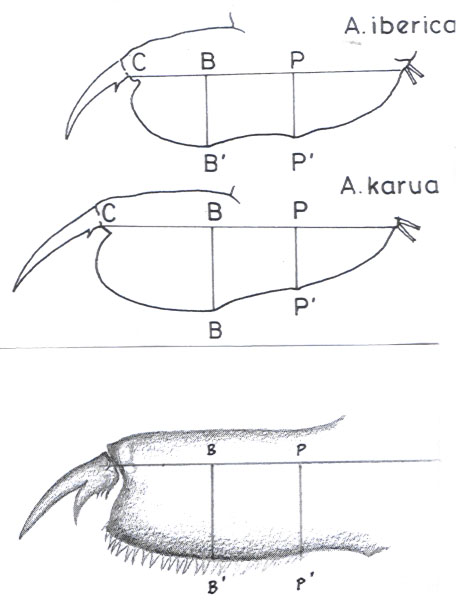
A new species of Alona in Queensland
This article focuses on a species of the genus Karualona (Dumont and Silva-Briano 2000) from Dakabin, Queensland.
Prior to the research of Dumont and Silva-Briano raising the species Alona karua to generic rank, the genus was only a species group. The only significant work done on the species group of a species native to Queensland, was in 1853, near Stroud in New South Wales (King) and 1888 near Rockhampton (Sars). Sars in 1888, re-examined the 1853 species of King, but was clearly of two minds whether he was indeed looking at the same species. On balance though he thinks they are. He writes “though the tail in his drawing looks somewhat different but I am inclined to regard both of these forms as identical” (Alonso and Prentus)
Five (5) species of genus Karualona are currently recognised (Dumont and Silva-Briano 2000), but only one lives in Queensland. Three parthenogenetic females are examined from Western Australia (Dumont and Silva-Briano 2000) where that species is renamed Karualona karua (King, 1853), as opposed to King’s original description as Alona karua. Clearly Dumont and Siva-Briano consider the Western Australian specimens of 1989 to be the same species as King’s New South Wales species of 1853, as did Sars with his study of 1888. A further collection (Smirnov 1974) near Rolleston, Queensland is considered also (Alonso and Prentus) to be A. karua, because of its similarity to the description given by Sars (1888).
A species collected from Dakabin, between Brisbane and Caboolture though is clearly of the genus Karualona, but fails to look anything like the species Karualona Karau (King, 1853). We need to consider the differences between this species and Karualona Karau.
In a study of a new species of Alona, named A Iberica (Alonso and Prentus), there is a detailed analysis of the difference between A. Karua and A. Iberica. We are not so much interested here in what A. Iberica looks like but very interested in A. Karua. There is a substantial analysis (p474) of the contrast in the shape of the postabdominal claw of A. Karua and A.Iberica. The contrast is used to justify the differenciation between the two species, and this is supported by a detailed analysis of angular difference between cross-sections at both ends of a concave dip in the abdominal claw in both species. The analysis uses correlation analysis, and line of best fit and standard deviation of variation in cross section angle within a sample (standard error) to establish the difference in species, based on the angle and concavity of the dip in both species.
By contrast however, the specimen from Dakabin shows no such dip at all. The lower margin of the postabdominal claw is not concaved at all. The illustrations given show only one spur on the postabdominal claw, however it is possible the authors only omitted that detail to focus attention on the angular differences with the body of the claw. The same publication (page 469) though shows diagams of A. karua from Sars 1888 and there is no secondary spur on the specimen there either. That is not to say of course that some species of genus Karualona do not have that secondary spur on the postabdoninal claw. The diagram on page 76 of Dumont and Siva-Briano shows that feature from a specimen from Yemen, but there is no way the Dakabin, Queensland species could be related to a species from Yemen.

The comparison shown here, (partly from the illustrations from Alonso and Pretus) show the postabdominal claw of A. iberica and A. karua. As can be seen there shape in both cases is different to the lower example (drawn using my enlargement technique). The Dakabin species has the lower margin of the postabdominal claw almost parallel with the upper margin, whereas the other two species show a definite angle. The second spur on the claw is also much more pronounced as is the case in A. alsafadii (Dumont and Briano, p76). An electron microscope picture (Dumont and Briano p77 photo 3) confirms the shape of the postabdominal claw of A. karua as having the strong concave dip.
Naturally a good deal of work still remains to be done to determine the species of this animal but I am of the general view that we have a new species native to Queensland.
The other chance of course, is that it is a known species and it is just that nobody has got around to describing it, or , more likely, no publisher has considered an obscure species from Queensland to have enough merit to devote editorial space to, given that printing and paper is expensive, subscriptions few, and interest little. That could, of course be the case.
If any member of the QNC or others have any comments they would like to contribute to the issue that would be most welcome. Any comments, you can e-mail the writer Robert Constantine , by clicking on this e-mail link.
References.
Alonso, M and J.L. Prentus, 1989, “Alona iberica, new species: first evidence of noncosmopolitanism within the A. Karua complex (Cladocera: Chydoridae )” Journal of Crust Biol. 9: 453 – 476
Dumont Henri J and Silva-Briano Marcelo, 2000, “Karualona n.gen (Anomopoda: Chydoridae), with a description of two new species, and a key to all known species”, Hydrobiologia 435: 61-82.
